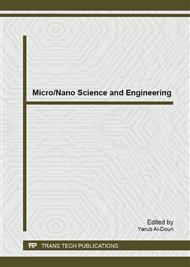p.533
p.538
p.543
p.548
p.553
p.559
p.564
p.570
p.575
Probing Electron Lifetime and Recombination Dynamics in Large Area Dye-Sensitized Solar Cells by Electrochemical Impedance Spectroscopy
Abstract:
A number of nanocrystalline, mesoporous large area (~0.2- 2 cm2) dye-sensitized solar cells (DSSCs) are probed by electrochemical impedance spectroscopy measurements to realize their carrier dynamics such as charge transport resistance (RCT), electron diffusion coefficient (Dη), and electron lifetime (τn) by applying an equivalent electrical model. The experimental upshots reveal that the electron lifetime relates with the device physical parameters which was neglected in previous studies. It is also found that the RCT relates negatively with the device area i.e. it decrease upon increasing photo-exposed area. The observed lowering of current density (JSC) over a series of experiments upon increasing the photoelectrode area is attributed to the decrease in RCT. The charge carriers upon injection into semiconductor layer find increased diffusion pathways and eventually recombine with the hole species when characterized by lower carrier lifetime. The thickness of the electrode film does not play an effective role indicating that the dynamics of larger area DSSCs differs largely from those of a single cell. The experimental results available indicate that a nearly complete collection of charge carriers is possible in large area modules provided the physical dimensions of photoelectrode area are considered. The results from the study hints future directions to build high efficiency DSSC modules and further asserts considering the diffusion length in two-dimensions while fabricating larger area cells.
Info:
Periodical:
Pages:
553-558
Citation:
Online since:
April 2014
Price:
Сopyright:
© 2014 Trans Tech Publications Ltd. All Rights Reserved
Share:
Citation:



